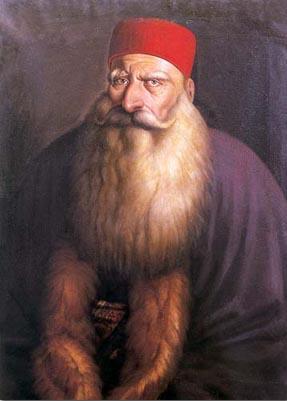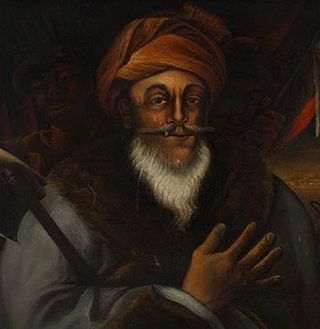Related Research Articles
Zahir al-Umar al-Zaydani,alternatively spelled Dhaher el-Omar or Dahir al-Umar,was an Arab ruler of northern Palestine in the mid-18th century,while the region was part of the Ottoman Empire. For much of his reign,starting in the 1730s,his domain mainly consisted of the Galilee,with successive headquarters in Tiberias,Deir Hanna and finally Acre,in 1750. He fortified Acre,and the city became the center of the cotton trade between Palestine and Europe. In the mid-1760s,he reestablished the port town of Haifa nearby.

Bashir Shihab II was a Lebanese emir who ruled the Emirate of Mount Lebanon in the first half of the 19th century. Born to a branch of the Shihab family which had converted from Sunni Islam,the religion of previous Shihabi emirs,he was the only Maronite ruler of the Mount Lebanon Emirate.

Ahmed Pasha al-Jazzar was the Acre-based Ottoman governor of Sidon Eyalet from 1776 until his death in 1804 and the simultaneous governor of Damascus Eyalet in 1785–1786,1790–1795,1798–1799,and 1803–1804. Having left his native Bosnia as a youth,he began a military career in Egypt in the service of mamluk officials,eventually becoming a chief enforcer and assassin for Ali Bey al-Kabir,Egypt's practical ruler. He gained the epithet of al-Jazzar for his deadly ambush on a group of Bedouin tribesmen in retaliation for the death of his first master in a Bedouin raid. Al-Jazzar fell out with Ali Bey in 1768 after refusing to take part in the assassination of another of his former masters. He ultimately fled to Syria,where he was tasked by the Ottomans with defending Beirut from a joint assault by the Russian Navy and Zahir al-Umar,the Acre-based ruler of northern Palestine. He eventually surrendered and entered Zahir's service before defecting from him and fleeing with stolen tax money.

The Shihab dynasty is an Arab family whose members served as the paramount tax farmers and emirs of Mount Lebanon from the early 18th to mid-19th century,during Ottoman rule (1517–1918). Before then,the family had been in control of the Wadi al-Taym region,purportedly as early as the 12th century. During early Ottoman rule,they maintained an alliance and marital ties with the Ma'n dynasty,the Chouf-based,paramount Druze emirs and tax farmers of Mount Lebanon. When the last Ma'nid emir died without male progeny in 1697,the chiefs of the Druze in Mount Lebanon appointed the Shihab emir,Bashir,whose mother belonged to the Ma'n,as his successor. Bashir was succeeded by another Shihab emir with a Ma'nid mother,Haydar,after his death.
Mustafa Agha Barbar El Korek was an Ottoman Syrian statesman and military officer who was governor of the Ottoman province of Tripoli,ruling between 1800–08,1810–20 and 1821-35.
As'ad Pasha al-Azm was the governor of Damascus under Ottoman rule from 1743 to his deposition in 1757. He was responsible for the construction of several architectural works in the city and other places in Syria.
Sulayman Pasha al-Azm was the governor of Sidon Eyalet (1727–33),Damascus Eyalet,and Egypt Eyalet (1739–40) under the Ottoman Empire. He belonged to the prominent Al-Azm family and was the uncle of As'ad Pasha al-Azm,who succeeded him as governor of Damascus,and Sa'deddin Pasha al-Azm,who also served as governor of Egypt.

Al-Azm family is a prominent Damascene family. Their political influence in Ottoman Syria began in the 18th century when members of the family administered Maarrat al-Nu'man and Hama. A scion of the family,Ismail Pasha al-Azm,was appointed wāli of Damascus Eyalet in 1725. Between 1725 and 1783,members of the family,including As'ad Pasha al-Azm,held power in Damascus for 47 years,in addition to periodical appointments in Sidon Eyalet,Tripoli Eyalet,Hama,Aleppo Eyalet,and Egypt Eyalet. The family's influence declined in the 19th century,failing to establish a true dynasty.
Abdullah Pasha al-Azm was an Ottoman statesman who served as the governor of the Damascus Eyalet,Aleppo Eyalet (1794),Egypt Eyalet (1798),Adana Eyalet,and Rakka Eyalet (1809),before retiring to Hama in the 1810s. He was a member of the prominent political family,Al-Azm.

Amir al-hajj was the position and title given to the commander of the annual Hajj pilgrim caravan by successive Muslim empires,from the 7th century until the 20th century. Since the Abbasid period,there were two main caravans,one departing from Damascus and the other from Cairo. Each of the two annual caravans was assigned an amir al-hajj whose main duties were securing funds and provisions for the caravan,and protecting it along the desert route to the Muslim holy cities of Mecca and Medina in the Hejaz.
Nasif ibn al-Nassar al-Wa'ili was the most powerful sheikh of the rural Shia Muslim (Matawilah) tribes of Jabal Amil in the mid-18th century. He was based in the town of Tebnine and was head of the Ali al-Saghir clan. Under his leadership,the Jabal Amil prospered,due largely to the revenues from dyed cotton cloth exports to European merchants.
Sulayman Pasha al-Adil was the Ottoman governor of Sidon Eyalet between 1805 and 1819,ruling from his Acre headquarters. He also simultaneously served as governor of Damascus Eyalet between 1810 and 1812. He was a mamluk of his predecessor,Jazzar Pasha. His rule was associated with decentralization,a reduction of Acre's military,and limits to his predecessors' cotton monopoly. Moreover,he oversaw a policy of non-interference with his deputy governors,such as Muhammad Abu-Nabbut and Mustafa Agha Barbar,and diplomacy with the autonomous sheikhs of the various Levantine regions where he held authority,including Emir Bashir Shihab II and Musa Bey Tuqan. He exercised control over his domain largely through depending on the loyalty of his deputies,who also had been mamluks of Jazzar. In effect,Sulayman Pasha presided over the world's last functioning mamluk system.
Shamdin Agha was an Ottoman Kurdish commander of irregulars in the service of the Ottoman governors of Damascus and Sidon Eyalet. In effect,he was powerful paramilitary chieftain in Damascus. His descendants became a prominent family with his namesake,Shamdin,in Ottoman Syria.
The 1757 Hajj caravan raid was the plunder and massacre of the Hajj caravan of 1757 on its return to Damascus from Mecca by Bedouin tribesmen. The caravan was under the protection of an Ottoman force led by the Wali of Damascus,Husayn Pasha,and his deputy Musa Pasha,while the Bedouin were led by Qa'dan al-Fayez of the Bani Sakher tribe. An estimated 20,000 pilgrims were either killed or died of hunger or thirst as a result of the raid.
Abdullah Pasha ibn Ali was the Ottoman governor (wali) of Sidon Eyalet between May 1820 and May 1832,with a nine-month interruption in 1822–23. Like his predecessors Jazzar Pasha and Sulayman Pasha,Abdullah Pasha ruled from the port city of Acre. During his reign,all of Palestine and the Syrian coastline came under his jurisdiction. Among his major military victories was his survival of an imperial-backed siege of Acre in 1822 instigated by the Farhi family in retaliation for Abdullah's execution of his mentor Haim Farhi,the suppression of revolts in Mount Lebanon and Jerusalem in 1824 and 1826,respectively,and the 1831 capture of the Sanur fortress.
Ismail Pasha al-Azm was an Ottoman statesman who served as the governor of Damascus and amir al-hajj in 1725–1730. Prior to this post he served as the agha of Ma'arrat al-Nu'man and steadily moved up the ranks to become the governor of the districts of Ma'arrat al-Nu'man,Hama and Homs in 1719 and then governor of Tripoli in 1721 before being assigned to the Damascus governorship.
Ibrahim Pasha Qatarağasi was an Ottoman statesman who served as wali (governor) of the Aleppo,Damascus,Diyarbekir and Tripoli eyalets (provinces) in the early 19th century.
Silahdar Süleyman Pasha was the Ottoman governor of Damascus Eyalet from February 1812 to May 1816.
Ibrahim Deli Pasha was an Ottoman Kurd who served as the governor of Damascus in 1788.
The sieges of Tiberias occurred in late 1742 and the summer of 1743 when the Ottoman governor of Damascus,Sulayman Pasha al-Azm,twice attempted and failed to eliminate the increasingly powerful,Tiberias-based multazim,Zahir al-Umar,and destroy his fortifications.